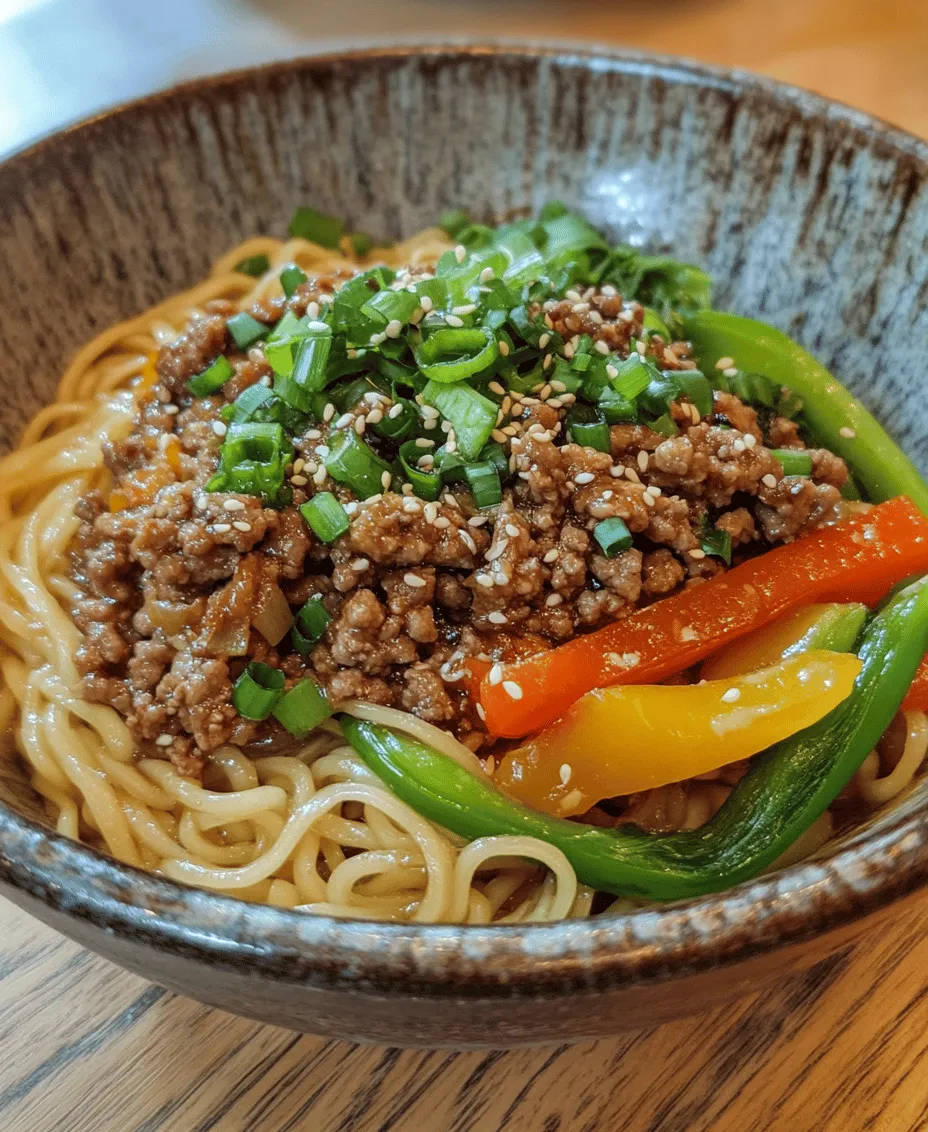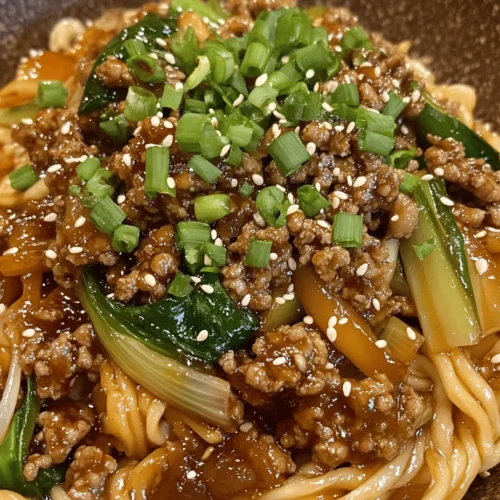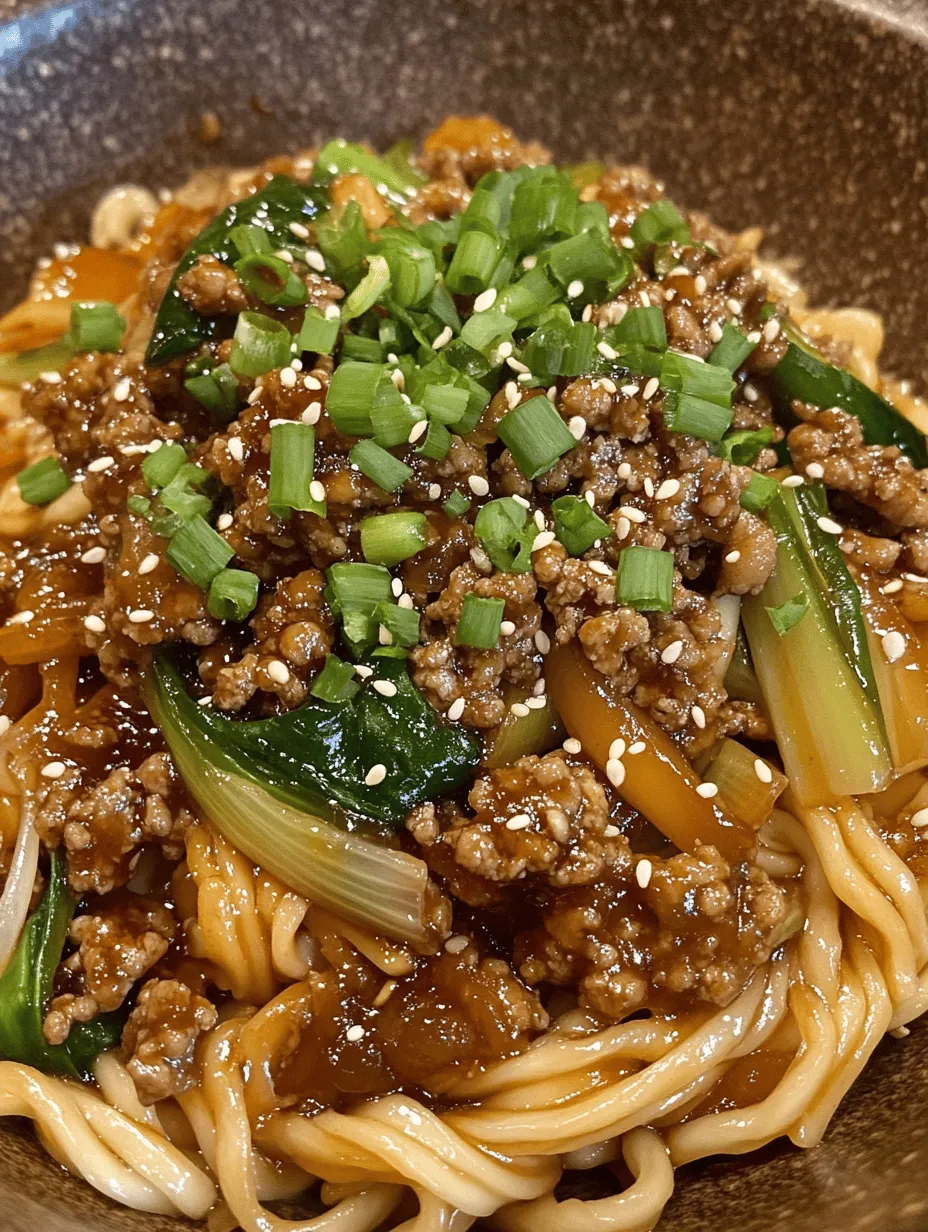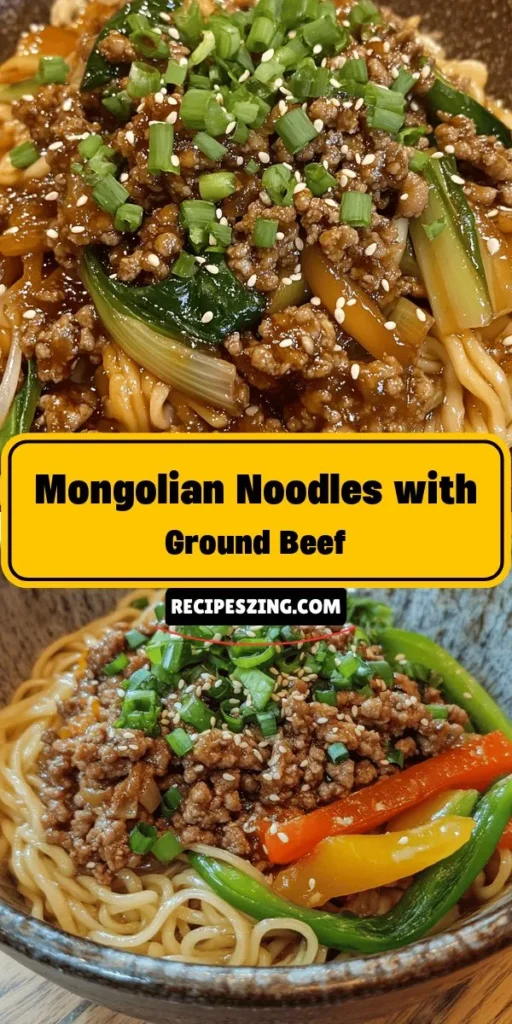Introduction
Mongolian cuisine is a delightful blend of flavors and ingredients that reflect the country’s rich cultural history and nomadic lifestyle. Known for its hearty meals and the use of fresh ingredients, Mongolian food often features a variety of meats, vegetables, and, most importantly, noodles. One standout dish that encapsulates the essence of Mongolian cooking is Mongolian Noodles with Ground Beef. This dish is not only a feast for the senses but also a practical choice for a weeknight dinner, thanks to its simplicity and quick preparation time. In this article, we’ll explore the flavors of Mongolian cuisine, delve into the history of noodles in Mongolia, and provide a detailed step-by-step guide to making this delicious dish.
Understanding Mongolian Noodles
The origins of noodles in Mongolian cooking are both fascinating and complex. Noodles are believed to have been introduced to Mongolia through trade routes that connected the region to China and Central Asia. Historically, Mongolian nomads relied on readily available ingredients, leading to the creation of dishes that are both nourishing and satisfying. The adaptability of noodles made them an ideal staple, as they could be paired with various meats and vegetables that were often on hand.
In traditional Mongolian cuisine, noodles are more than just a side dish; they are a central component that provides sustenance and energy. Commonly made from wheat, Mongolian noodles can be found in various forms, from thick dumplings to thin, delicate strands. The versatility of noodles allows them to absorb the flavors of accompanying sauces and ingredients, making them a perfect vehicle for the bold and savory tastes characteristic of Mongolian dishes.
Common Ingredients in Mongolian Dishes
The ingredients used in Mongolian cooking often reflect the region’s pastoral lifestyle. Meat, particularly lamb and beef, is a staple, accompanied by a variety of vegetables and seasonings. In contrast to more prominent rice-based Asian cuisines, Mongolian dishes frequently incorporate noodles as a primary carbohydrate source.
Some common ingredients found in Mongolian noodle dishes include:
– Wheat flour: The foundation for making noodles, which provides the necessary structure and chewiness.
– Meat: Ground beef is often used in noodle dishes, but lamb or chicken can also be incorporated based on personal preference.
– Vegetables: Bok choy, bell peppers, carrots, and onions are frequently used for their flavor and nutritional benefits.
– Soy sauce and other condiments: Essential for bringing depth and umami to the dish.
The Significance of Noodles in Mongolian Culture
Noodles hold a special place in Mongolian culture, representing nourishment and community. Often served during family gatherings or celebrations, noodle dishes are a way to bring people together. The act of sharing a meal, particularly one centered around noodles, symbolizes unity and connection among family and friends. The ease with which these noodles can be prepared makes them a popular choice for both everyday meals and festive occasions.
Ingredients Overview
As we dive into the recipe for Mongolian Noodles with Ground Beef, it’s essential to understand the specific ingredients that will elevate this dish. Each component contributes not only to the overall flavor but also to the dish’s nutritional profile.
Egg Noodles: Options and Alternatives
At the heart of our dish are egg noodles, which offer a rich flavor and a tender texture. While traditional egg noodles are preferred, you can also use other types of noodles, such as:
– Udon noodles: Thick and chewy, these Japanese noodles can be a great substitute.
– Rice noodles: A gluten-free option that provides a different texture and taste.
– Whole wheat noodles: For a healthier choice that adds fiber to your meal.
Regardless of the type you choose, ensure that the noodles are cooked al dente to maintain their structure when tossed with the other ingredients.
Ground Beef: Choosing Quality Meat
The quality of the ground beef you select can significantly impact the overall flavor of your dish. When shopping for ground beef, look for meat with a balance of fat and lean content, ideally around 80/20. This ratio ensures that the beef remains juicy and flavorful without becoming overly greasy. If possible, choose grass-fed beef for a richer taste and better nutritional profile.
Vegetables: Nutritional Benefits of Bok Choy and Bell Peppers
Fresh vegetables play a crucial role in enhancing both the flavor and nutritional value of Mongolian Noodles.
– Bok Choy: This leafy green is packed with vitamins A, C, and K, as well as calcium and potassium. Its mild flavor and crunchy texture make it an excellent addition to stir-fried dishes.
– Bell Peppers: Available in various colors, bell peppers add a sweet, crisp element to the dish. They are rich in vitamins A and C, and their vibrant hues make the dish visually appealing.
Sauces: Explanation of Soy Sauce, Oyster Sauce, Hoisin Sauce, and Sesame Oil
The sauces used in this recipe are key to achieving the authentic flavor profile of Mongolian Noodles.
– Soy Sauce: This staple condiment provides a salty, umami flavor that enhances the overall taste of the dish.
– Oyster Sauce: Known for its savory depth, oyster sauce adds a slightly sweet and earthy note, complementing the other ingredients beautifully.
– Hoisin Sauce: Often described as a Chinese barbecue sauce, hoisin adds a sweet and tangy flavor, contributing to the overall complexity of the dish.
– Sesame Oil: A drizzle of sesame oil at the end of cooking adds a nutty aroma that elevates the dish’s flavor profile.
When preparing Mongolian Noodles with Ground Beef, using high-quality ingredients is essential to achieving the best results. Freshness matters, so opt for locally sourced vegetables and high-quality sauces to bring out the dish’s vibrant flavors.
Step-by-Step Guide to Preparing Mongolian Noodles
Now that we’ve covered the ingredients, let’s move on to the step-by-step process of preparing Mongolian Noodles with Ground Beef. Following these instructions will ensure you achieve a delicious and satisfying meal.
Cooking the Noodles
The first step in making Mongolian Noodles is cooking the noodles properly. Start by bringing a large pot of salted water to a rolling boil.
1. Add the Noodles: Carefully add the egg noodles to the boiling water. Stir gently to prevent them from sticking together.
2. Cook Until Al Dente: Follow the package instructions for cooking time, usually around 4-6 minutes. The key is to cook them until they are al dente—firm to the bite—so they hold up well when mixed with the other ingredients.
3. Drain and Rinse: Once cooked, drain the noodles in a colander and rinse them under cold water to stop the cooking process. This also helps remove excess starch, preventing them from becoming gummy.
Importance of Cooking Noodles Properly for Texture
Cooking the noodles to the right texture is crucial for the overall success of the dish. Properly cooked noodles should be chewy and absorb the flavors of the sauces and other ingredients without becoming mushy.
Tips on Achieving Al Dente Noodles
– Keep an Eye on Timing: Start checking the noodles a minute or two before the recommended cooking time.
– Taste Test: Use a fork to taste a noodle to ensure it has the desired firmness.
– Avoid Overcooking: Remember that the noodles will continue to cook slightly after being drained, so it’s better to err on the side of undercooking.
Sautéing Aromatics
Once the noodles are ready, it’s time to build the flavor base for our Mongolian Noodles. Aromatics like onions, garlic, and ginger are essential for creating depth in the dish.
1. Heat Oil in a Wok or Large Skillet: Place a wok or a large skillet over medium-high heat and add a tablespoon of vegetable oil.
2. Add Onions: Once the oil is shimmering, add diced onions. Sauté them for about 2-3 minutes until they become translucent and slightly golden.
3. Incorporate Garlic and Ginger: Next, add minced garlic and grated ginger to the pan. Sauté for an additional 1-2 minutes, stirring constantly to avoid burning.
Role of Onions, Garlic, and Ginger in Flavor Development
Onions provide a sweet and savory base, while garlic and ginger add aromatic warmth and spice. Together, these ingredients create a fragrant foundation that enhances the overall flavor of the dish.
Techniques for Maximizing Aromatic Flavors
– Use Fresh Ingredients: Fresh garlic and ginger will provide the best flavor. Avoid using pre-minced varieties if possible.
– Cook Until Fragrant: Always sauté aromatics until they are fragrant, as this signifies that the flavors have developed and will be evenly distributed throughout the dish.
Browning the Beef
Now that the aromatics are ready, it’s time to add ground beef to the mix.
1. Add Ground Beef to the Pan: Increase the heat to high and add the ground beef to the wok. Use a spatula to break up the meat as it cooks.
2. Season the Beef: Season with salt and pepper. You can also add a splash of soy sauce at this stage for extra flavor.
3. Cook Until Browned: Sauté the beef for about 5-7 minutes, or until it is browned and cooked through. The key is to achieve a good sear on the meat, as this caramelization brings out rich, savory flavors.
How to Achieve a Perfect Sear on Ground Beef
– Don’t Overcrowd the Pan: If you’re making a large batch, consider cooking the beef in batches to allow it to sear properly.
– Leave It Alone: Avoid stirring the meat too often. Let it sit in the pan for a minute or two to develop a nice crust before breaking it apart.
Discussing Seasoning for Optimal Taste
Seasoning is essential for bringing out the natural flavors of the ground beef. In addition to salt and pepper, feel free to experiment with your favorite spices or add a dash of chili flakes for a bit of heat.
Incorporating Vegetables
Finally, it’s time to add the vegetables to the mix. This step not only adds color and texture but also boosts the dish’s nutritional profile.
1. Add Vegetables: Once the beef is browned, add sliced bok choy and bell peppers to the pan. Stir-fry for about 3-4 minutes, or until the vegetables are tender yet crisp.
2. Stir in the Cooked Noodles: After the vegetables are cooked, add the drained noodles back into the wok.
3. Add Sauces: Pour in the soy sauce, oyster sauce, hoisin sauce, and a drizzle of sesame oil. Toss everything together until the noodles are well-coated with the sauces and heated through.
Cooking Times for Maintaining Crispness in Vegetables
To maintain the crispness of the vegetables, avoid overcooking them. Aim for vibrant colors and a slight crunch, which will contrast beautifully with the tender noodles and savory beef.
By following these steps, you will set a strong foundation for a delicious Mongolian dish that captures the essence of this unique cuisine. The combination of flavors and textures will undoubtedly make your Mongolian Noodles with Ground Beef a delightful addition to your meal rotation, showcasing the simplicity and heartiness of Mongolian cooking. Stay tuned for the final steps and tips on perfecting this dish in the next part of our recipe series.

Nutritional Benefits of Eating a Variety of Vegetables
Incorporating a variety of vegetables into your diet, as showcased in this Mongolian Noodles with Ground Beef recipe, holds immense nutritional value. Vegetables are rich in essential vitamins, minerals, and antioxidants that support overall health. They can help improve digestion, boost the immune system, and reduce the risk of chronic diseases. Each vegetable contributes unique nutrients; for example, bell peppers offer vitamin C, while broccoli provides fiber and vitamin K. By adding an assortment of vegetables to your dish, you not only enhance the flavor but also ensure a well-rounded meal that promotes a healthy lifestyle.
Mixing the Sauces
The Art of Combining Sauces for Depth of Flavor
The heart of Mongolian Noodles lies in its sauce, which adds depth and complexity to the dish. For this recipe, a mixture of soy sauce, oyster sauce, and a hint of sesame oil creates a savory base that beautifully complements the ground beef and vegetables.
To combine the sauces effectively, mix the following in a small bowl before adding them to the noodles:
– Soy Sauce: Provides a salty umami flavor.
– Oyster Sauce: Adds sweetness and richness.
– Sesame Oil: Contributes a nutty aroma.
– Optional Chili Paste: For those who enjoy a bit of heat, adding a teaspoon of chili paste can elevate the dish with a spicy kick.
Adjusting Spice Levels with Optional Chili Paste
Adjusting spice levels is crucial when preparing Mongolian Noodles. If you prefer a milder flavor, you can simply omit the chili paste. For spice enthusiasts, however, incorporating this ingredient can enhance the dish’s character and warmth. Start with a small amount, taste, and gradually increase until you reach your desired spiciness. Remember, it’s easier to add more than to tone down an overly spicy dish.
Combining Noodles and Ingredients
Techniques for Tossing and Mixing to Ensure Even Coating
Once your noodles are cooked and drained, it’s time to combine them with the sauce, beef, and vegetables. This step is essential to ensure that every strand of noodle is evenly coated with flavor.
1. In a large skillet or wok, heat a tablespoon of oil over medium-high heat.
2. Add the cooked ground beef and sauté briefly to reheat.
3. Toss in the assorted vegetables, cooking until they’re just tender but still crisp.
4. Pour the prepared sauce over the beef and vegetables, stirring to combine.
5. Finally, add the cooked noodles, gently tossing everything together with tongs or a spatula. This method helps avoid breaking the noodles while ensuring they absorb the sauce thoroughly.
Tips for Serving Temperature and Presentation
For optimal flavor and enjoyment, serve your Mongolian Noodles hot. A sizzling presentation adds to the dish’s appeal. Use a large serving platter or individual bowls to showcase the vibrant colors of the noodles and vegetables.
To enhance the visual appeal:
– Garnish with finely chopped green onions and sesame seeds.
– Consider adding a sprinkle of crushed red pepper for an attractive pop of color.
The Cultural Significance of Mongolian Noodles
Mongolian Noodles are not just a delicious dish; they also reflect the rich tapestry of Asian culinary traditions. Often enjoyed in family settings, these noodles embody the spirit of sharing and togetherness prevalent in many Asian cultures.
Comparison with Similar Dishes from Neighboring Cultures
Mongolian Noodles share similarities with stir-fried noodles from China and other Asian cuisines. The fundamental technique of stir-frying with a variety of vegetables and proteins is a common theme across these dishes. However, the unique blend of sauces and the addition of specific vegetables can set Mongolian Noodles apart, showcasing its distinct flavor profile.
The Role of Noodles in Family Gatherings and Celebrations
In many Asian cultures, noodles symbolize longevity and prosperity, making them a popular choice for celebrations and family gatherings. The act of sharing a large plate of noodles represents unity and the joy of being together, making this dish a perfect choice for special occasions or casual dinners alike.
Nutritional Analysis
Breakdown of the Nutritional Content of the Dish
Mongolian Noodles with Ground Beef are not only satisfying but also nutritionally balanced. A typical serving contains:
– Calories: Approximately 450
– Protein: 25 grams from the ground beef and added vegetables
– Carbohydrates: 55 grams primarily from the noodles
– Fats: 15 grams, with healthy fats from sesame oil
Health Benefits of Incorporating Lean Protein and Vegetables
Using lean ground beef provides essential protein, which is crucial for muscle repair and growth. The addition of vegetables ensures you are getting vital nutrients, including fiber, which aids digestion and keeps you feeling full longer. This balance of protein and vegetables makes the dish a wholesome option for any meal.
Gluten-Free Alternatives for the Dish
For those with gluten sensitivities, there are several alternatives to traditional wheat noodles. Rice noodles or gluten-free pasta can be used to create a similar texture and flavor without compromising on taste. Just ensure to adjust the cooking time as needed for these substitutes.
Balancing This Meal Within a Healthy Diet
While Mongolian Noodles can be part of a balanced diet, it’s important to consider portion sizes and overall daily intake. Pairing this dish with a side salad or steamed vegetables can enhance its nutritional value and help maintain a well-rounded meal.
Creative Variations and Substitutions
Suggestions for Vegetarian or Vegan Adaptations
If you’re looking to make a vegetarian or vegan version of Mongolian Noodles, consider substituting ground beef with plant-based alternatives such as crumbled tofu, tempeh, or soy protein. Additionally, using a mix of mushrooms can provide a savory depth to the dish.
Options for Enhancing the Dish with Additional Protein Sources
There are various ways to enhance the protein content of the dish. Adding cooked shrimp, chicken, or even eggs can create a protein-rich meal that satisfies. Adjust the cooking time to ensure all proteins are cooked thoroughly.
Ideas for Customizing Flavors with Different Vegetables or Spices
One of the beautiful aspects of Mongolian Noodles is their versatility. Feel free to experiment with different vegetables such as snap peas, carrots, or bok choy. You can also customize the flavors with spices like ginger or garlic, which can elevate the dish even further.
Presentation and Serving Suggestions
Tips for Plating Mongolian Noodles Attractively
To create an inviting presentation, carefully arrange the noodles in the center of the plate, allowing the colorful vegetables to cascade over the top. Consider using a ring mold for a neat and structured presentation.
Best Practices for Garnishing with Green Onions and Sesame Seeds
When garnishing, fresh green onions add a bright pop of color and flavor. Sprinkle sesame seeds generously to enhance both the aesthetic and textural elements of the dish. A drizzle of additional sesame oil can add a final touch of flavor.
Recommended Side Dishes or Beverages to Complement the Meal
Mongolian Noodles pair wonderfully with side dishes such as a refreshing cucumber salad or steamed dumplings. For beverages, consider serving jasmine tea or a light Asian lager, which complements the flavors without overpowering them.
Conclusion
Mongolian Noodles with Ground Beef is a dish that beautifully balances flavor, nutrition, and cultural significance. With its hearty ingredients and quick preparation, it is an ideal meal for busy weeknights or casual gatherings. The versatility of this recipe allows for countless variations, making it a beloved choice for many households.
As you explore the joys of cooking, remember that sharing homemade meals with loved ones creates lasting memories. The experience of preparing and enjoying Mongolian Noodles can inspire you to experiment with flavors and ingredients, fostering a deeper appreciation for the culinary arts. We encourage you to try this quick, flavorful dish and relish the satisfaction of serving a meal that is not only delicious but also nourishes the body and soul.



